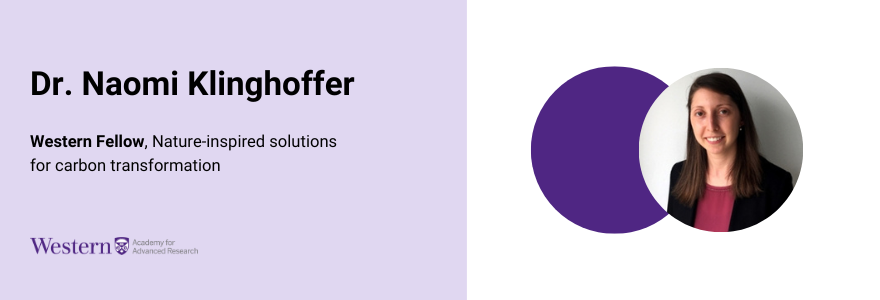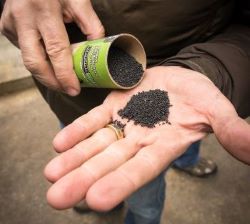News
Contact Us
Western Academy for Advanced ResearchWestern Interdisciplinary Research Building
Western University
London, Ontario
N6A 3K7
wafar@uwo.ca
Connect with us today!


In conversation with Naomi Klinghoffer

Biochar looks a lot like coal dust, and yet it could help us protect our environment.
 When decomposing plants are heated through a thermochemical process known as pyrolysis, you get biochar. This process captures carbon that would otherwise be released into the atmosphere as carbon dioxide, turning it into a sustainable agricultural product that could bolster food production.
When decomposing plants are heated through a thermochemical process known as pyrolysis, you get biochar. This process captures carbon that would otherwise be released into the atmosphere as carbon dioxide, turning it into a sustainable agricultural product that could bolster food production.
Naomi Klinghoffer (Western Engineering, ICFAR) believes that biochar could play an important role in the effort to tackle climate change. As a Western Fellow with the Nature-inspired solutions for carbon transformation research theme of the Western Academy, Naomi is working with Theme Leader Chris DeGroot (Western Engineering) and Western Fellow Elizabeth Webb (Earth Sciences) to investigate how emerging technologies—like biochar— can be used to slow the growth of carbon emissions.
Before joining Western as an Assistant Professor in Chemical and Biochemical Engineering, Naomi worked with stakeholders in the energy sector to investigate renewable alternatives to fossil fuels. Along with colleagues Chris DeGroot and Elizabeth Webb, Naomi advocates for a circular economy that transforms waste into value.
This interview has been edited and condensed for clarity.
What interests you about biochar in particular?
I am interested in the concept of leaving no waste. I look at it in this way: how can we create a circular economy? That’s the goal. In any chemical process, you have to look at all the byproducts and try to understand how to make use of everything. Developing sustainable processes and reducing our environmental impacts means developing technologies that use everything, and avoid waste disposal.
"I look at it this way: how can we create a circular economy? That's the goal."
Have you always been interested in the idea of a circular economy?
I was an environmental nerd as a child, even when I was in elementary school. My mom was upset that our school didn’t have a recycling program, so we started one at the school. When I started my work in chemical engineering, I was interested in how environmental applications can be used to create a circular economy. The concept of a circular economy is new, but I have always valued the idea of an economy that produces as little waste as possible.
You have drawn some attention for your work with biofuels, a renewable alternative to fossil fuels. Can you tell me more about it?
I like the “all of the above approach.” I think we need to look at each sector and understand that the needs are going to be different for each. For example, we can replace [fossil fueled] passenger vehicles with electric and we are on the path to doing that. But in other sectors--like in the aviation industry--we cannot electrify as easily. We need high energy density fuel to get us to our destination, and, in that case, hydrocarbons are the best solution.
One of the most prominent ways to decarbonize the industry is through the production of sustainable aviation fuel from sustainable feedstocks, meaning biomass. We are working on a technology to convert biomass residues into a sustainable aviation fuel. There are a lot of targets within the aviation industry saying they want to start blending sustainable aviation fuel into their existing fuel, so there is a realistic pathway towards commercialization.
"We can take carbon from a tree, and we can carbonize it [...] to make something very stable, where carbon is going to be stored for a very long time.
How has your work with the Nature-inspired solutions for carbon transformation theme changed the way you think about your research?
Our team members come from different areas of expertise, but we have found many points of connection. An example is biochar. One application for biochar is carbon storage. If you were to leave a tree to decompose it would produce carbon dioxide that would be returned to the atmosphere. We can take carbon from a tree, and we can carbonize it through the process of pyrolysis to make something that’s very stable, where carbon is going to be stored for a very long time.
This pathway presents a promising means to reduce atmospheric carbon dioxide. Biochar can also be added to the soil to improve soil quality. I have been working with Liz [Webb], who has expertise in soil chemistry and soil science, to understand biochar’s carbon storage potential and its impacts on the soil.
Chris [DeGroot]’s expertise is in wastewater and modelling. Wastewater treatment produces sludge and biosolids. We are looking at how to convert this waste into biochar, which we can then use for applications, like removal of contaminants from wastewater.
Have you made any strange or unexpected discoveries in the course of your work with the Nature-inspired solutions theme?
Liz works with isotopes. She showed me that you can use isotopes to understand the history of forest fires. Forest fires produce biochar, and its properties can give you information about the fire such as its temperature. We’re using that concept in our reactor work, in a process where we use biochar catalysts to make sustainable fuels out of carbon dioxide. Isotope tracing helps us measure the stability of the biochar.
"It feels like we have so many ways of developing new solutions, and now is the time to do it."
Do you think this discovery can help us better understand forest fires or even help us find new ways of managing them?
I think this discovery is starting to open a door for me in terms of how we can use these tools to better understand what’s happening in our systems. It’s exciting to work with collaborators with different expertise, and learn about new ways to better understand and improve the systems that I am working with.
What else would you like us to know?
Historically, we’ve relied upon this linear cycle where you use something and then you throw it out. In some ways it feels new to be saying this is not the way to do it-- we have to make things circular. That’s how nature works. There’s no such thing as waste in nature. There are endless opportunities to improve the efficiency of resource use and to improve the way we dispose of things. It’s exciting. It feels like we have so many ways of developing new solutions, and now is the time to do it.
Interview by Lindsey Bannister

